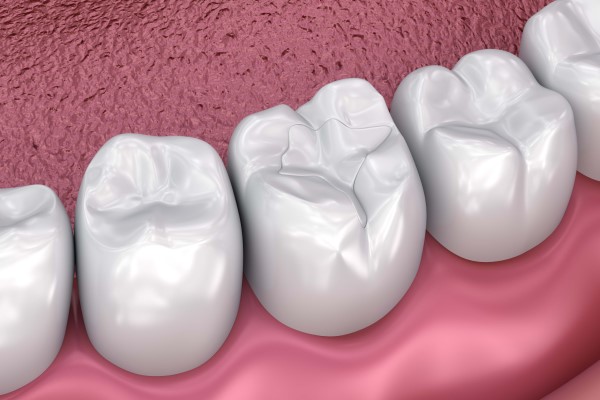Is a White Dental Filling Strong?

Patients are often given the choice of a white dental filling to seal and protect the tooth after receiving dental work. White fillings can be a good option for patients who want a filling that will blend in with their smile and last for a number of years. However, while these fillings are strong enough for many purposes, they are not the right choice for every patient.
How are white fillings different than amalgam fillings?
When a patient receives a dental filling, a hole is drilled in the tooth and the decay is removed with a drill or air abrasion instrument. After ensuring that the decay is completely gone, the dentist fills in the hole with a material designed to seal the tooth and prevent further decay. Fillings can be made of several different types of material, including gold, silver amalgam, plastic, and porcelain.
White fillings
White dental fillings are typically made by blending ceramic and glass or plastic to create a composite material. These fillings are popular because they are nearly invisible and they bond with the tooth, making them a more attractive option for front teeth and smaller cavities that do not require extensive drilling.
Amalgam fillings
Amalgam fillings are usually silver in color and can be made from a mixture of metals such as silver, tin, and mercury. Gold-colored filings may contain real gold. Mercury can be a concern in older fillings for some patients, but studies have shown that the mercury from the fillings will not poison a patient or lead to health risks.
Pros and cons of white dental fillings
The type of filling selected is determined by the patient’s unique case, medical history, and at times, cosmetic wishes. Each type of filling comes with advantages and disadvantages including cost, visibility, and durability.
Pros of white dental fillings
White fillings are the same color as teeth, so patients who do not want visible dental work typically prefer the composite option. Unlike metal fillings that may cause allergic reactions in sensitive patients, white fillings are typically hypoallergenic. They also do not expand and contract when exposed to extreme heat and cold like silver fillings do.
Cons of white dental fillings
White fillings tend to be more expensive overall than silver or gold. Receiving white fillings also involves a longer dental procedure than receiving metal fillings due to the fact that metal hardens more quickly than the composite material. Amalgam fillings, in general, are more durable than the white type. They tend to last longer and take on more wear and tear, especially if the patient has bruxism and applies a lot of force to the molars.
Conclusion
A white dental filling is often recommended for patients who have concerns about the visibility of dental work, who desire a hypoallergenic filling, and who have relatively few other dental concerns. If your dentist suggests proceeding with this type of filling, rest assured that it is a strong choice for your teeth.
Are you considering white dental filling in the Troy area? Get more information at https://www.thanasasdds.com.
Check out what others are saying about our dental services on Yelp: Composite Fillings in Troy, MI.
Recent Posts
When individuals experience cavities and other problems that affect their teeth, dentists use a dental filling to repair and restore them. This helps preserve damaged teeth and prevents their loss. Dental fillings are the most common type of dental work: according to the Centers for Disease Control and Prevention, over 90% of Americans have had…
A dental filling is most often used to treat cavities. If a patient has a cavity, the dentist removes decay from the tooth and fills the area. Likewise, the filling material can repair cracked and broken teeth. There are several materials available for dental fillings. Materials include porcelain, gold, silver amalgam, and composite resin.You may…
According to the Centers for Disease Control and Prevention, 90% of people develop a cavity by the time they reach the age of 20. A dental filling is often used as a treatment option for this very common dental issue. A filling is relatively easy to place and effectively treats tooth decay. While the treatment…
Curious about mercury free dentistry? Read on to learn more about the use of mercury free dental restoration options. The discovery of amalgam fillings more than a century ago transformed the treatment of dental decay and cavities. Dental patients were in danger of losing their teeth before fillings were introduced. Amalgam fillings made of mercury…


